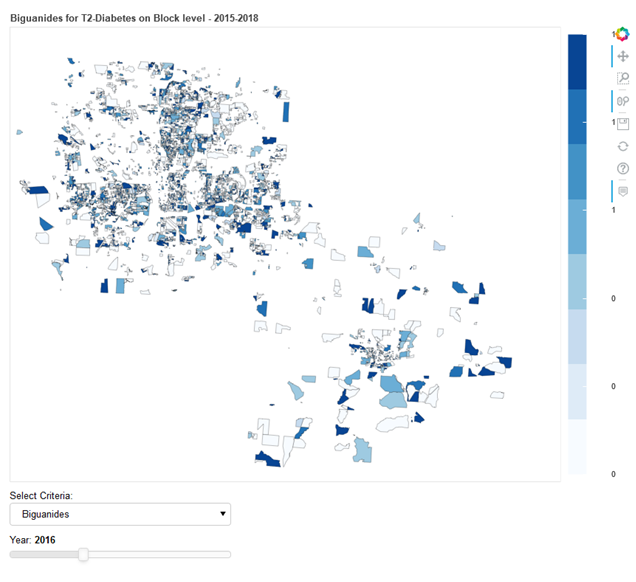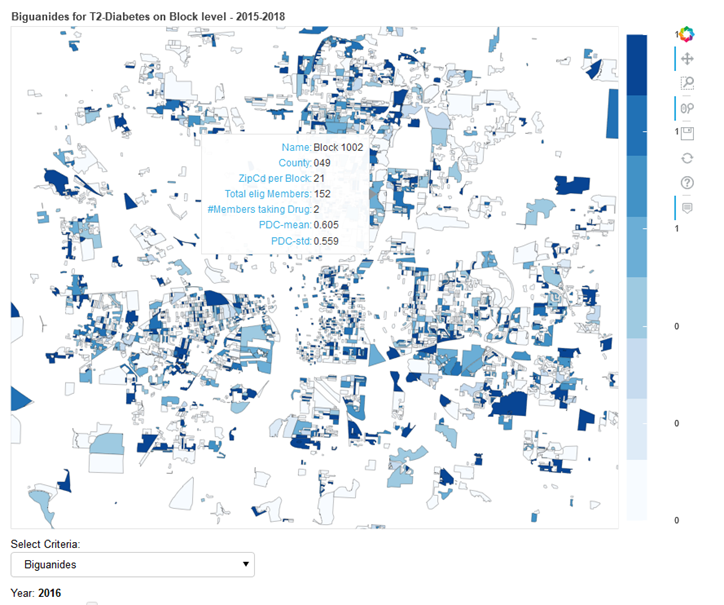We eventually have published our long-term work, looking at environmental influences on cognitive health (longitudinal study) in the journal Environment International.
Spatial Ventures – Geospatial Services
Working for a Sustainable Future
We eventually have published our long-term work, looking at environmental influences on cognitive health (longitudinal study) in the journal Environment International.
Our work with Health Research Institute of University of Canberra involved designing an interactive Sankey diagram. We chose the Highcharts JavaScript library.
Below Sankey chart shows residential moves registered in a U.S. state within neighbourhoods assigned with a socioeconomic disadvantage index
(Ref. see Neighbourhood Atlas). This Area deprivation index is mapped on U.S census blockgroup level. The lines in the grapph below represent moves between classes of deprivation scores, from one area (on left) to another (on right).
We used AU nation-wide 2021 GNaf address points (n 15,150,683), and 2021 meshblock polygons (n 368,255) – attributing each point with a meshblock attribute. Runtime: 104 seconds
Steps:
Create spatial tables, e.g. with SELECT STV_ShpCreateTable ( USING PARAMETERS file = '/data_au/MB_2021_AUST_GDA94.shp') OVER() AS spatial_data;
copy data:COPY data_au.mb_2021_aust_gda94 WITH SOURCE STV_ShpSource(file='/data_au/MB_2021_AUST_GDA94.shp', SRID=4283) PARSER STV_ShpParser(); EXCEPTIONS 'data1/vertica_data/exceptions_ralf'; commit;
We can pull the points file (with x/y coordinates):copy data_au.aus_gnaf_aug21 from '/data_au/aus_gnaf_aug21_prem_2021.csv' PARSER fcsvparser(header=true);
and add geometry:alter table data_au.aus_gnaf_aug21 add column geom geometry;
UPDATE data_au.aus_gnaf_aug21 SET geom = STV_GeometryPoint(lon, lat, 4283); commit;
Create spatial index for the polygon data; set ram-memory to 10 gig
(default 256 mb); we use the mb_code created as integer column:SELECT STV_Create_Index(mb_code_int, geom USING PARAMETERS index='mb_index', overwrite=true, max_mem_mb = 10000) OVER() FROM data_au.mb_2021_aust_gda94;
Perform point in polygon selection: (point id has to be unique & integer):SELECT STV_Intersect(id, geom USING PARAMETERS index='mb_index') OVER (PARTITION BEST) AS (point_id, polygon_gid) FROM data_au.aus_gnaf_aug21
We can re-run and join using gnaf_pid to get point_ids with mb_codes, this time we also account for invalid point data (where-clause):Select aa.gnaf_pid, polygon_gid as mb_code_int from data_au.aus_gnaf_aug21 aa
join (
SELECT STV_Intersect(id, geom USING PARAMETERS index='mb_index') OVER (PARTITION BEST) AS (point_id, polygon_gid) FROM data_au.aus_gnaf_aug21
where not (geom is null or id is null)) bb on aa.id=bb.point_id
Results:
After a few years of data compiling, and analysis – a further paper is now published supporting urban planning – for integrating a 20min neighbourhood strategy. It ensures that people have the aility to meet most of their daily needs within a 20-minute walk/non-motorised trip from their home. It is already part of the planning policies of some city councils.
See the article in the Int. Journal of Behavioral Nutrition and Physical Activity of the project lead by Deakin University (IPAN).
Another publication of our collaborative work with spatial and multi-level analysis has been accepted.
This research applied geospatial techniques to explore small area geographic variation, spatial clustering, and spatial convergence in medication adherence to diabetes medication. This enabled an examination of where populations at high risk of non-adherence are concentrated.
It is available here.
Our paper is finally out.
We examined whether Socio-Economic Indexes for Areas (paricularly, the Index of Relative Socioeconomic Disadvantage – IRSD) should be based on a more locally sensitve indicator, in contrast to the existing national and state-based rankings. This aims to develop more suitable rankings, esp. for regional areas.
Please see our article in the Journal of Australian Population Studies.
Chronic diseases have a widespread impact on health outcomes and medication adherence is one main factor to improve the health status. Based on medical claims data hold by medical insurers or management services, adherence patterns of members with chronic diseases, such as type2 diabetes or cardiovascular disease can be identified based on their diagnosis claims (ICD codes), and related prescription claims with their days-of-supply information for fills of a given drug in a particular time period. Assessing these prescription claims, the adherence to a specific drug or drug-class can then be calculated through the proportion of days covered (pdc).
We generated a python based programming solution, computing pdc medical adherence on a patient basis, per drug and per year. The data is plotted using the python library bokeh – also allowing for the generation of interactive displays (bokeh server). Some outputs are shown below.

Further, python bokeh is employed for producing a web-based interactive map output, illustrating aggregated medical adherence data (pdc) per drug-class on a census unit level: The application below enables the user to select a specific drug-class, and setting the year of analysis with the time-slider.

Zoom into the feature map is possible, and census units reveal feature information when hovering over.

We have created a 3D Model of the Great Artesian Basin (GAB), based on 10 hydrostratigraphic formations- 6 Aquifer and 4 Aquitard units – using open-source tools such as paraview; see this link – on our website.
Spatial Ventures conducted an environmental and groundwater suitability study – for the establishment of a fish hatchery in Northern Victoria.
A project the Victorian State Government is keen to get finalised under the guidance of the Victorian Fisheries Authority.
See also under https://vfa.vic.gov.au/about/media-releases/exploring-native-fish-hatchery-sites
…and latest updates under https://vfa.vic.gov.au/recreational-fishing/targetonemillion2/new-native-fish-hatchery
Adb announced the launch of the Afghan GeoPortal in Kabul, Afghanistan.
Initially, Spatial Ventures’ national GIS feasibility study had been a first step to leading to this result.
See the announcement here.